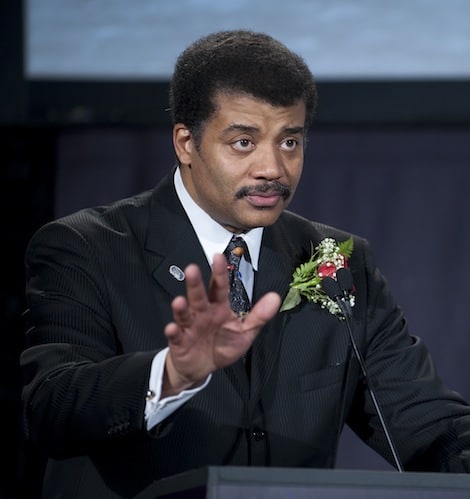Heavy clouds prevented a clear view of the sky on Friday evening, but Convocation Hall was host to its own star when Neil deGrasse Tyson delivered the inaugural Dunlap Prize Lecture. The Dunlap Prize was established to recognize “an individual whose remarkable achievements resonate with the Dunlap Institute’s goal of excellence in astronomy and astrophysics… sharing scientific discovery with the public, training the next generation of astronomers, and developing innovative astronomical instrumentation to enable breakthroughs in observational research.”

MEDIA PHOTO
Dr. Tyson was awarded the 2014 Dunlap Prize in recognition of his dedication to science education and outreach. With a galaxy tie, a ready sense of humour, and a twinkle in his eye, Tyson delivered a talk entitled The Cosmic Perspective (scientific, cultural, political, sociological observations). He spoke about the importance of science literacy in moving society forward, developing economies, and cultivating dreams.
Although it has been eight years since the demotion of Pluto, Tyson felt compelled to ensure that the dwarf planet’s fate had been accepted, emphasizing that “it’s still not a planet.” At this and all points in the lecture, Tyson was engaged with the audience, often posing questions to specific audience members and walking around the floor of the auditorium. At the end of his discussion of Pluto, he had a slide prepared to respond to disappointed members of the audience, which simply said, “Get Over It.”
In order to illustrate the global distribution of scientific research, Tyson displayed maps that were distorted according to total amount of peer-reviewed scientific publications per country. Canada was moderately sized with respect to the research currently published, but when the land distribution was adjusted according to the trendline of scientific research, Canada withered away to almost nothing. Tyson asked, “what’s going on with your science?” There was an audible murmur from the audience; more than a few people muttered “Harper.” Tyson chuckled. Distorting maps according to the strength of national economies, he said, yields nearly the same map as the one representing trends in scientific research. He consistently emphasized that science, influence, and power go together, and that science is the “foundation of modern civilization.” Canada’s technological achievements garnered enthusiastic praise from Tyson, who celebrated the placement of the Canadarm on the five dollar note. He later said that he hoped it didn’t hurt too much to remove the hockey stick.
After reflecting on the smallness of human life from a cosmic perspective, Tyson mused, “Some people would say, well I don’t feel special anymore. I would say, how much more special can you be? We are of the universe. The universe is in us — that’s a connectivity to the cosmos, that you are a participant in the great unfolding of a cosmic story.”
Carl Sagan invited a 17-year-old Neil deGrasse Tyson to spend a day with him at Cornell, and Sagan has been a major influence on Tyson ever since. Tyson has followed in Sagan’s footsteps in many ways, from his dedication to science communication to his reprisal of Sagan’s Cosmos. In 1990, Voyager 1 “took a selfie of Earth,” as Tyson put it, and Carl Sagan’s comment on the photo became known as the Pale Blue Dot reflection. In 2013, the Cassini spacecraft took a similar photo. To pay homage to Sagan, Tyson displayed the Cassini photo and ended the lecture with “a recitation from the Book of Carl.” The audience sat in silent anticipation as house lights went to zero, and he began.

